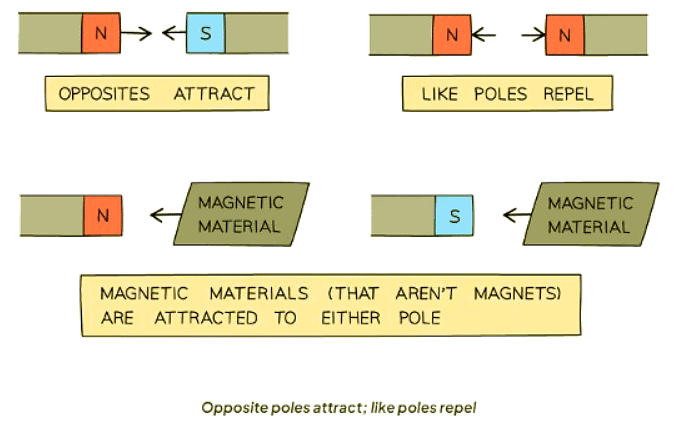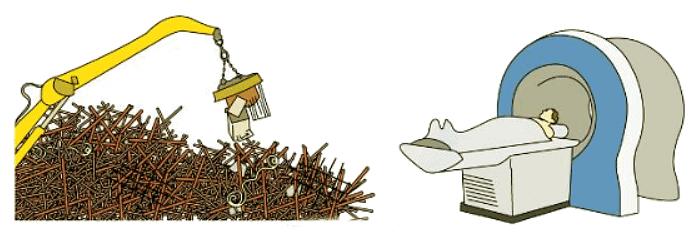Class 10 Exam > Class 10 Notes > Physics for GCSE/IGCSE > Magnetism
Magnetism | Physics for GCSE/IGCSE - Class 10 PDF Download
Magnetism
- The ends of a magnet are referred to as poles.
- Magnets possess two poles: a north pole and a south pole.

- Magnets are objects that exhibit attraction and repulsion.
- Similar poles repel each other. For instance, a north pole repels another north pole, and a south pole repels another south pole.
- Unlike poles attract each other. For example, a north pole is attracted to a south pole.
- When two magnets are close, a force acts between them.

- Magnetic materials:
- Experience a force in a magnetic field.
- Are attracted to a magnet when not magnetized.
- Can be magnetized to become a magnet.
- Only a magnet can repel another magnet, serving as a useful test for magnetism.
- Non-magnetic materials do not respond to magnetic fields by experiencing a force.
Uses of Magnets
Uses of Permanent Magnets
- Permanent magnets are commonly crafted from steel, although exceptions exist.
- These magnets possess a lasting magnetic quality.

- These magnets possess a lasting magnetic quality.
- Permanent magnets serve various purposes, such as:
- Compasses: Utilized for navigation over centuries due to their consistent alignment with the Earth's magnetic north.
- School lab experiments: Employed in educational settings to illustrate magnetic principles.
- Toys: Magnetized components in toy trains and trucks that connect carriages to the engine or cab.
- Fridge magnets: Constructed from flexible magnetic material or by affixing a magnet to an object's back.
Uses of Electromagnets
- Electromagnets operate by using electricity to induce magnetism in a current-carrying wire.
- One key advantage of electromagnets is their ability to be magnetized or demagnetized instantly with a switch.
- They are easily turned on and off, providing flexibility in their magnetic properties.
- Soft iron is typically employed in electromagnets due to its capability to become a temporary magnet.

- Electromagnets have many uses including
- MRI Scanners: In medical facilities, MRI scanners are large machines that utilize strong electromagnets to create detailed images of the body's organs.
- Speakers and Earphones: Devices like phones and laptops employ electromagnets in their loudspeakers, microphones, and earphones to transmit and receive sound waves effectively.
- Recycling: Steel, being a magnetic material, can be segregated from other substances through electromagnets, aiding in its reuse and minimizing the need for new steel production.
- Mag-Lev Trains: Mag-Lev trains operate by utilizing large electromagnets to hover above the tracks, reducing friction and enabling speeds up to approximately 400 miles per hour.
Question for MagnetismTry yourself: What is the purpose of using permanent magnets in toy trains and trucks?View Solution
The document Magnetism | Physics for GCSE/IGCSE - Class 10 is a part of the Class 10 Course Physics for GCSE/IGCSE.
All you need of Class 10 at this link: Class 10
|
126 videos|182 docs|35 tests
|
FAQs on Magnetism - Physics for GCSE/IGCSE - Class 10
| 1. What are the different uses of magnets in everyday life? |  |
Ans. Magnets are commonly used in various applications such as in electric motors, MRI machines, speakers, refrigerator doors, and magnetic therapy products.
| 2. How do magnets work to attract or repel objects? |  |
Ans. Magnets have a magnetic field that exerts a force on other magnets or magnetic materials, causing them to be attracted or repelled based on the orientation of their poles.
| 3. Can magnets lose their magnetism over time? |  |
Ans. Yes, magnets can lose their magnetism over time due to factors such as exposure to high temperatures, physical damage, or being dropped repeatedly.
| 4. What is the relationship between magnetism and electricity? |  |
Ans. Magnetism and electricity are closely related through electromagnetism, where an electric current produces a magnetic field and a changing magnetic field can induce an electric current.
| 5. Are all materials affected by magnets in the same way? |  |
Ans. No, different materials exhibit varying degrees of magnetism, with some being attracted to magnets (ferromagnetic materials) and others being repelled (diamagnetic materials).
Related Searches





















